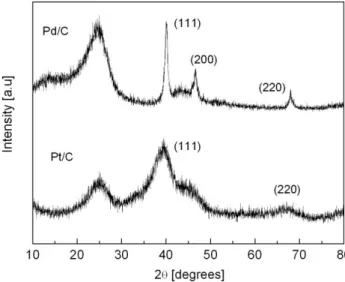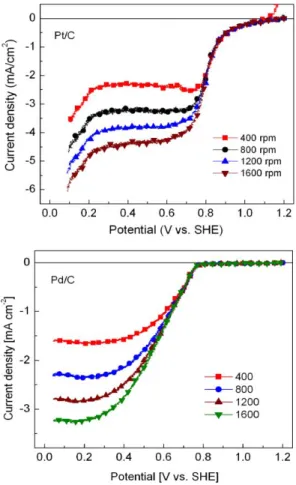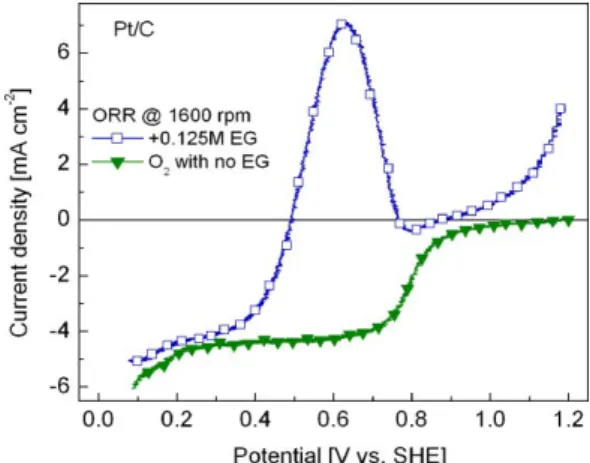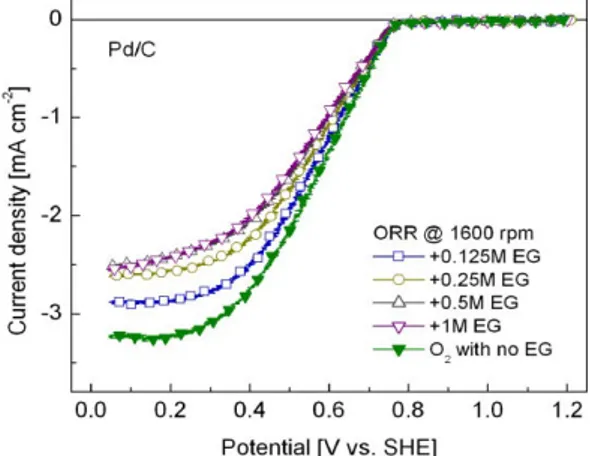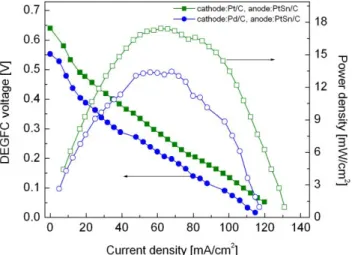Titre:
Title: Synthesis and Evaluation of Highly Tolerant Pd Electrocatalysts as Cathodes in Direct Ethylene Glycol Fuel Cells (DEGFC)
Auteurs:
Authors: F. Javier Rodríguez Varela, Sergio Luna et Oumarou Savadogo
Date: 2009
Type: Article de revue / Journal article
Référence:
Citation:
Rodríguez Varela, F. J., Luna, S. & Savadogo, O. (2009). Synthesis and Evaluation of Highly Tolerant Pd Electrocatalysts as Cathodes in Direct Ethylene Glycol Fuel Cells (DEGFC). Energies, 2(4), p. 944-956. doi:10.3390/en20400944
Document en libre accès dans PolyPublie
Open Access document in PolyPublie
URL de PolyPublie:
PolyPublie URL: https://publications.polymtl.ca/3393/
Version: Version officielle de l'éditeur / Published version Révisé par les pairs / Refereed Conditions d’utilisation:
Terms of Use: CC BY
Document publié chez l’éditeur officiel
Document issued by the official publisher
Titre de la revue:
Journal Title: Energies (vol. 2, no 4)
Maison d’édition:
Publisher: MDPI
URL officiel:
Official URL: https://doi.org/10.3390/en20400944
Mention légale:
Legal notice:
Ce fichier a été téléchargé à partir de PolyPublie, le dépôt institutionnel de Polytechnique Montréal
This file has been downloaded from PolyPublie, the institutional repository of Polytechnique Montréal
energies
ISSN 1996-1073
www.mdpi.com/journal/energies
Article
Synthesis and Evaluation of Highly Tolerant Pd Electrocatalysts
as Cathodes in Direct Ethylene Glycol Fuel Cells (DEGFC)
Francisco Javier Rodríguez Varela 1,*, Sergio Fraire Luna 1 and Oumarou Savadogo 2
1 Grupo de Recursos Naturales y Energéticos, Cinvestav Unidad Saltillo, Carr. Saltillo-Monterrey Km.
13.5, Ramos Arizpe, Coahuila, C.P. 25900, Mexico
2 Laboratoire d'Électrochimie et de Matériaux Énergétiques, École Polytechnique de Montréal, C.P.
6079, succ. Centre-Ville, Montréal, QC, H3C 3A7, Canada
* Author to whom correspondence should be addressed; E-Mail: javier.varela@cinvestav.edu.mx; Tel.: +52-844-438-9612; Fax: +52-844-438-9610.
Received: 29 July 2009 / Accepted: 11 September 2009 / Published: 27 October 2009
Abstract: Highly selective Pd electrocatalysts were synthesized by the formic acid (FA)
method and evaluated as cathodes for DEGFC applications. In rotating disc measurements in acid medium, the Pd/C cathode showed important catalytic activity for the Oxygen Reduction Reaction (ORR). In the presence of ethylene glycol (EG, C2H6O2), Pd/C
exhibited a noteworthy electrochemical behavior and full tolerance to the organic molecule. No current density peaks associated to the EG oxidation reaction emerged and the shift in onset potential for the ORR (Eonset) toward more negative potentials was negligible on this
cathode. As a comparison, commercial Pt/C was tested under the same conditions showing a poor selectivity for the ORR when EG was present. The detrimental effect of EG on the Pt electrocatalysts resulted in high intensity current density peaks due to the oxidation of EG and a significant shift in Eonset. The evaluation of Pd/C in a DEGFC operating at 80 °C
demonstrated its good performance as cathode material. Given these results, it is expected that highly efficient Pd-based cathodes can find application in DEGFCs.
Keywords: Pd-based cathodes; oxygen reduction reaction; tolerance to organic molecules;
1. Introduction
Direct Oxidation Fuel Cells (DOFCs) are an excellent alternative to H2/O2 PEMFCs in applications
such as low-power electronic devices (laptops, PDAs, etc.) or stand-alone back up power systems. Nowadays, Direct Methanol and Ethanol Fuel Cells (DMFCs and DEFCs, respectively) are the most common fuel cells fueled with organic molecules, delivering high power densities at temperatures around 80 °C [1-4]. In recent years, very important technological constraints related to DOFCs have been overcome, one of the most important being the depolarization of anodes and cathodes based on Pt-alone electrocatalysts. The loss of catalytic activity of Pt during the electro-oxidation of small organic molecules results in significantly high anode overpotentials and lower fuel cell performances. Moreover, the crossover of relatively small amounts of liquid fuel and/or reaction intermediates to the cathode side of the MEA causes a significant increase in cathode overpotentials and a remarkable lower onset potential for the ORR when Pt-alone cathodes are used [1-9]. Recently, the development of alcohol-tolerant cathode electrocatalysts allowed for a reduction in efficiency losses due to the presence of liquid substances in the cathode chamber of DOFCs. In this context, when highly tolerant Pt-alloys [3,6-8], Pd-based [10-16] or non-Pt electrocatalysts [2,17-20] cathodes were tested in half cell experiments and as cathodes in DOFCs, their electrochemical behavior resulted in very important
current density vs. cell voltage performances, and in some cases power densities comparable to those
obtained with Pt cathodes [7].
Meanwhile, besides methanol and ethanol, ethylene glycol (EG, C2H6O2) has been tested as an
organic fuel in DEGFCs. EG has high solubility in aqueous solutions [21,22] and is safer to handle as a fuel for FC applications than methanol [23]. Moreover, C2H6O2 is significantly less toxic than
methanol [24] and is widely available and cheap compared to other fuels, which is a very important issue in the development of low-cost FCs. Furthermore, the complete oxidation of C2H6O2
delivers 10 e-, i.e., more than CH
3OH (6e-) and it has been reported by Peled´s group that the theoretical
capacity of EG is higher than that of methanol (4.8 vs. 4 Ah/mL, respectively) [23]. The same group has successfully worked on the development of high power density DEGFCs [25-28].
However, the same problem related to poorly tolerant Pt-alone cathode electrocatalysts occurs with DEGFCs, i.e., the detrimental effect of ethylene glycol crossover through the polymer membrane, which is relatively high at commercially available membranes [27]. In recent communications, we have shown that the catalytic activity of Pt-alone electrocatalysts for the ORR is significantly reduced by the presence of EG in acid solutions and the value of Eonset is remarkably displaced towards more negative
potentials in the presence of relatively low concentrations of the liquid fuel [11,15,29]. In the same studies, the high degree of tolerance of Pd-containing electrocatalysts to the organic molecule is demonstrated, although the catalytic activity of these cathodes for the ORR in pure O2-saturated
solution is lower than the activity of Pt/C. Elsewhere, it has been reported that Pd-alloys, have shown higher activity for the ORR than Pd-alone and a high selectivity and tolerance to liquid fuels, mainly methanol [12-14] and ethanol [10,30,31].
Thus, the development of highly selective and tolerant ORR cathodes is a key issue for the development of high performance DEGFCs. In a recent paper related to this subject, Peled et al. made an extensive study of the effect of methanol, ethylene glycol and their corresponding by-products on the activity of Pt and Pt-alloys based cathodes for the ORR, reporting the high tolerance of the PtCoSn
system [32]. To the best of our knowledge, only references [15] and [29], along with this work, have been dedicated exclusively to the study of the tolerance of selective Pd-based cathodes to the C2H6O2
molecule. Also recently, it has been indicated that Pd may not be as electroactive for the oxidation of organic molecules in acid medium as it is in alkaline medium [33]. However, analyzing the results in [32] we consider that selectivity and tolerance studies related to Pd and/or Pd-alloys cathodes are of great interest for the development of high performance DEGFCs, considering that some reaction intermediates and/or by-products that result from the oxidation of EG may reduce the catalytic activity of such electrocatalysts for the ORR. Thus, the aim of this work is to evaluate the performance of Pd electrocatalyst prepared by the formic acid method in our laboratory for the ORR in half cell and in a DEGFC. The electrocatalytic activity and selectivity of Pd/C are presented. Its performance as cathode material in a DEGFC is evaluated and compared to that of a commercial Pt/C cathode. Further work currently being carried out in our labs is indicated.
2. Results and Discussion
2.1. Physicochemical Characterization
The composition of Pd/C and Pt/C was evaluated by EDX. In both cases, it was found that the actual composition in different microareas was lower than the nominal composition. The results are shown in Table 1. It should be kept in mind that these results correspond to an average composition and some of them were three times tested in order to verify their reproducibility. Figure 1 shows the XRD patterns of the home-prepared Pd/C and the commercial Pt/C. Both diffractograms display the characteristics of fcc Pt and Pd with peaks corresponding to the (111), (200) and (220) planes. The average particle sizes (d) calculated from the features of peak (220) using the Scherrer equation [2,3] are presented in Table 1. It can be seen that d corresponding to Pd/C (10.1 nm) is significantly larger than that of Pt/C (2.2 nm). The large d value of Pd/C may be related to the reducing power of FA, which may be an important aspect as reported elsewhere [34,35].
Table 1. Chemical composition and characteristics of supported Pd and Pt electrocatalysts. Electrocatalyst (wt. %) EDX Particle size (nm) XRD Particle size (nm) TEM
Pd/C 16.5 10.1 9.7
Pt/C 17.1 2.2 2.4
TEM images in Figure 2 show the distribution of Pd and Pt particles on the Vulcan support. Some cluster-like particles were formed during the synthesis of Pd/C (Figure 2a) with a low homogeneity and slightly narrow particle size distribution. Meanwhile, a homogeneous distribution can be observed in the case of Pt/C (Figure 2b). The d values for Pd/C and Pt/C determined from TEM analysis (see inserts in Figure 2) are presented in Table 1. The results indicate larger average size for Pd/C particles (9.7 nm) than the average size of Pt/C particles (2.4 nm), in good correlation with XRD results.
Figure 2. TEM micrographs of Pd/C (a) and Pt/C (b).
2.2. Evaluation of ORR Activity and Tolerance to C2H6O2
Figure 3 shows the linear scan voltammograms (LSV) of the ORR without EG on Pt/C and Pd/C. The curves show the expected increase in current densities at higher rotation rates and diffusion of oxygen onto the catalyst surface. It is seen in this Figure that Eonset is higher at Pt/C than that at Pd/C.
From the shape of the curves in Figure 3, it appears that the ORR at Pd/C is under kinetic and mixed control in the potential region scanned. The disc current densities j can be related to the kinetic (jk) and
diffusional (jd) current densities by using the well-known Levich relationship (Equation 1). Other
parameters, such as the Nafion film diffusion are considered to have no effect in the shape of the curves in Figure 3, because the amount of Nafion used in this study is very small (ca. 30 L of 5 wt% Nafion in 5 mL of solution): 2 / 1 1 1 1 1 1 B j j j j k d k (1)
Figure 3. Polarization curves of the ORR at Pt/C and Pd/C. Electrolyte: 0.5 M H2SO4.
Temperature: 25 °C. Scan rate: 5 mV/s.
1/j vs. 1/1/2 plots at several potentials corresponding to the experimental values of Pd/C in the
mixed controlled region (from Figure 3) are shown in Figure 4. The plots show linearity and parallelism, indicating first-order kinetics with respect to O2 [36]. The parallelism in the Levich-Koutecky plots
suggests that the number of electrons transferred during the ORR reaction do not change within the potential range scanned [36]. Also depicted in Figure 4 is the fitting of theoretical slopes for 4 and 2 e
-transfer reactions, calculated with the relationship:
2 6 / 1 3 / 2 2 . 0 nFD cO B (2) where 0.2 applies when is expressed in rpm, D is the diffusion coefficient of oxygen in sulfuric acid (1.4×10−5 cm2/s), c is the bulk concentration of oxygen (1.1×10−6 mol/cm3), is the kinematic viscosity
of the sulfuric acid (1.0×10−2 cm/s), F is the Faraday constant (96,500 C) and n is the number of
electrons transferred [17,36]. Clearly, the slopes of the experimental data in Figure 4 fit well with the theoretical slope related to a four e- transfer, suggesting that the ORR proceeds via an overall four
Figure 4. Levich-Koutecky plots corresponding to measured data of Pd/C (from Figure 3).
Figure 5 shows the LSVs of the ORR at Pt/C under = 1,600 rpm without and with 0.125 M EG. Evidently, the detrimental effect of relatively small amounts of C2H6O2 on the catalytic activity of Pt/C
is important, with the curve in the presence of the organic molecule displaying a high peak current density due to the ethylene glycol oxidation reaction (egor) at ca. 0.63 V vs. SHE. Moreover, the value
of Eonset shifts nearly 0.65 V toward more negative potentials in the EG-containing solution related to its
value without EG. Thus, the cathode overpotential at the Pt-alone material becomes appreciably higher in the presence of EG. Such low selectivity and poor electrochemical behavior of Pt/C in the fuel-containing solution is comparable to the loss in performance with ethanol [2] or methanol [8,37] shown by the same Pt/C material and indicates the need for novel cathodes tolerant to EG in order to engineer high performance DEGFCs.
Figure 5. LSV of the ORR in the presence of 0.125 M C2H6O2 at Pt/C. Rotation rate:
1,600 rpm. Electrolyte: 0.5 M H2SO4. Temperature: 25 °C . Scan rate: 5 mV/s. The
polarization curve without EG is also shown.
Figure 6 shows the LSVs of the ORR at Pd/C in acid solution containing increasing concentrations of EG (0.125, 0.25, 0.5 and 1 M). The selectivity toward the ORR and the full tolerance of the Pd electrocatalyst is demonstrated by a negligible shift in potential when EG is added to the electrolyte. For example, with 0.125M C2H6O2 the potential shifts less than 10 mV at 0.2 mA/cm2 related to the
potential in EG-free solution, a very small variation compared to a variation of nearly 0.250 V at Pt/C at the same current density with the same amount of C2H6O2 (see Figure 5). Moreover, no peak current
densities associated to the egor emerged at Pd/C, indicating its low electrocatalytic activity for this anodic reaction. This behavior suggests a zero or extremely low degree of adsorption of this organic fuel on the Pd catalytic sites. Similar electrochemical behavior was reported elsewhere regarding the performance of Pd and Pd-alloys in the presence of ethanol [10]. Such tolerance capacity gives important advantages to the family of Pd-based electrocatalysts as cathodes for DOFCs applications, i.e., highly tolerant Pd-cathodes may reduce the cathode overpotentials due to the crossover of liquid fuels and/or reaction intermediates through the polymer electrolyte, increasing the long term stability and allowing the fuel cell to deliver higher power densities.
The electrochemical behavior of Pd-based electrocatalysts in the presence of several organic molecules (e.g., ethylene glycol in this work or ethanol in previous works) suggests a multi-fuel capability of this family of materials, i.e., they may sustain high performances as cathodes in direct fuel cells fueled with a variety of liquid substances without being greatly affected by the crossover phenomena. One of the key issues should be the development of such electrocatalysts with narrow particle size distribution and homogeneous dispersion.
Figure 6. LSVs of the ORR in the presence of increasing concentrations of C2H6O2
(indicated) at Pd/C. Rotation rate: 1,600 rpm. Electrolyte: 0.5 M H2SO4. Temperature:
25 °C. Scan rate: 5 mV/s. The polarization curve without EG is also shown.
2.3. DEGFC Performance
Figure 7 shows a comparison of the current density vs. cell voltage performance obtained from a DEGFC equipped with Pd/C or Pt/C cathodes operating at 80 °C. Power density vs. current density plots are also shown. In both cases, PtSn/C anodes were used. All electrodes had a catalyst loading of 2 mg/cm2 and were prepared as described in the experimental section. It can be observed that the fuel
cell open circuit voltage with the Pd/C cathode is ca. 0.55 V, which is nearly 90 mV lower than that obtained with the Pt/C cathode. Also, at any given cell voltage, higher current densities are reached by the cell based on Pt/C. Concerning the maximum power density, the DEGFC equipped with Pd/C attained about 13.5 mW/cm2, while the cell based on the Pt/C cathode reached a maximum power
density of nearly 17.5 mW/cm2. The lower performance of the Pd-alone cathode compared to the
Pd/C material (Table 1). However, the results obtained here for Pd/C are of high interest since for the first time Pd-based electrocatalysts are being tested in a FC fueled with ethylene glycol. The difference in performance between the Pd cathode and the Pt cathode in the DEGFC at 80 °C is not enormous. Besides the Pd particle size, other parameters normally applied for Pt should be optimized for different electrocatalysts, such as the catalyst dispersion, electrode preparation, MEAs fabrication [2]. In doing so, better performances can be obtained from non-Pt cathodes.
Figure 7. Polarization curves of the DEGFC equipped with Pd/C or Pt/C cathodes at
80 °C. Anodes: PtSn/C. Catalyst loading in all electrodes: 2 mg/cm2. Membrane: Nafion®
117. EG concentration and flow rate: 1 M and 2 mL/min. Oxygen flow rate: 0.5 L/min without backpressure.
3. Experimental Section
3.1. Reagents
Palladium chloride (PdCl2) and analytical grade C2H6O2 and H2SO4 solutions were purchased from
Aldrich. Pt/C powders were from E-Tek. Ultrapure 18.3 MΩ deionized water and high-purity N2 and
O2 (AOC) were used during the experiments.
3.2. Synthesis of Carbon Supported Pd-based Electrocatalyst
The investigated Pd/C electrocatalysts were prepared by the formic acid method [35]. To prepare 2 g of the metallic electrocatalysts, Vulcan XC-72 (1,600 mg) was sonicated and stirred in 240 mL of deionized water for 30 min to form a slurry. The slurry was heated to 80 °C and this temperature was maintained throughout the synthesis process. Then, the required amount of the palladium precursor was added dropwise under stirring and the solution was continuously agitated for 30 min. Afterwards, an excess of 0.5 M formic acid solution was slowly added to the solution containing the precursors, which was left at the preparation temperature overnight under stirring. Subsequently, the resulting suspension
was left to cool to room temperature, filtered and thoroughly washed with deionized water. The nominal metallic loading of the electrocatalysts was 20 wt.% Pd/C.
3.3. Physicochemical Characterization
Semi-qualitative microarea elemental analyses were obtained with an energy dispersive X-ray set-up (EDX) coupled to a Jeol model JSM 6300 SEM microscope working at 40 kV. The powders were analyzed in a Philips X´Pert diffractometer (Cu Ka radiation source, λKα1 = 1.54060 Å). Diffractograms
were taken over 10-80 degrees with 0.025 steps. Also, TEM analysis was carried out in a Philips TECNAI-F30 HRTEM 300 kV apparatus. Average particle size were obtained from XRD and TEM measurements.
3.4. Catalytic Ink and Electrochemical Set-up
Experimental details regarding the preparation of the catalytic ink have been described elsewhere [2]. A brief description of the procedure is as follows: separately, each of the electrocatalysts was sonicated in deionized water and Nafion solution (DuPont). Then, 10 μL of the solution was dispersed onto a polished glassy carbon disc (5 mm diameter) and allowed to dry overnight. A bipotentiostat AFCBP1 from Pine Inst. was used to characterize the electrodes with a platinum mesh and a silver chloride (Ag/AgCl) as the counter electrode and the reference electrode, respectively. In this study, all potentials are reported vs. the standard hydrogen electrode (SHE). After activation of the electrocatalysts in deaereated electrolytes (with N2), linear scan voltammetry (LSV) measurements taken under rotating
conditions at 25 °C were performed in O2-saturated 0.5 M H2SO4 or 0.5 M H2SO4 + (0.125, 0.25, 0.5
or 1) M C2H6O2 solutions. The scan rate was 5 mV/s. The catalyst loading on each electrode was
ca. 51 μg/cm2. 3.5. DEGFC Fixture
Cathodes containing Pd/C or Pt/C powders were fabricated in our laboratory by a catalytic ink method described previously [3,38,39]. In order to complete the MEAs tested in the DEGFC setup, anodes containing commercial 20% PtSn/C (ETek) were prepared by the same procedure. In all cases, the catalyst loading was 2 mgcat/cm2. Previously, Nafion® 117 membranes used as the solid polymer
electrolyte were treated with H2SO4 and H2O2 to eliminate impurities and activate the sulfonic
groups [37]. MEAs were fabricated by the hot-press method as reported elsewhere [38,39]. Galvanic polarization curves were obtained from a 2.25 cm2 geometrical area fuel cell in a test station (FuelCon
Evaluator). Throughout the tests, non-preheated ethylene glycol was pumped to the anode side without backpressure at a flow rate of 2 mL/min. The EG concentration was 1 M. High purity O2 at a flow rate
of 0.5 L/min without backpressure was sent to the cathode chamber. The operating temperature of the cell was 80 °C.
4. Conclusions
In this work we explored the use of Pd-based electrocatalysts as ethylene glycol-tolerant cathodes in half cell and complete fuel cell fixtures. The average particle size of Pd/C synthesized by the formic acid method determined by XRD and TEM analyses was larger than that of commercial Pt/C. Stronger reducing agents such as sodium borohydride are currently being tested in our labs in order to control this parameter and obtain Pd powders within 2–5 nm particle size range. The Pd/C electrocatalysts showed a full tolerance to the organic molecule in acid medium, as demonstrated by the fact that the onset potential of the ORR shifted insignificantly in the presence of EG, related to the value in the absence of the molecule. Moreover, no peak current density due to the catalytic oxidation of C2H6O2
appeared at Pd/C during the linear scan, a behavior attributed to an extremely slow rate of adsorption of the molecule at the available Pd catalytic sites. In these studies, Pd cathodes were tested for the first time in EG fueled FCs. In the DEGFC, the cell based on a Pd/C cathode showed lower performance than the cell with Pt/C cathode. This difference can in part be attributed to the large particle size of Pd/C. However, important current and densities were delivered from the fuel cell when Pd/C was used.
Acknowledgements
The authors wish to thank the National Council for Science and Technology (Conacyt-México) for financial support through Grant No. 52024.
References
1. Aricò, A.S.; Srinivasan, S.; Antonucci, V. DMFCs: From fundamental aspects to technology development. Fuel Cells 2001, 1, 133-161.
2. Rodríguez Varela, F.J.; Savadogo, O. Catalytic activity of carbon-supported electrocatalysts for direct ethanol fuel cell applications. J. Electrochem. Soc. 2008, 155, B618-B624.
3. Rodríguez Varela, F.J.; Savadogo, O. Ethanol-tolerant Pt-alloy cathodes for direct ethanol fuel cell (DEFC) applications. Asia-Pac. J. Chem. Eng. 2009, 4, 17-24.
4. Zhou, W.J.; Li, W.Z.; Song, S.Q.; Zhou, Z.H.; Jiang, L.H.; Sun, G.Q.; Xin, Q.; Poulianitis, K.; Kontou, S.; Tsiakaras, P. Bi- and tri-metallic Pt-based anode catalysts for direct ethanol fuel cells.
J. Power Sources 2004, 131, 217-223.
5. Savadogo, O.; Rodríguez Varela, F.J. Ethanol-tolerant oxygen reduction reaction (orr) cathodes for direct ethanol fuel cell applications. Electrochemical Society Transactions 2006, 1, 331-338.
6. Lopes, T.; Antolini, E.; Colmati, F.; Gonzalez, E.R. Carbon supported Pt–Co (3:1) alloy as improved cathode electrocatalyst for direct ethanol fuel cells. J. Power Sources 2007, 164,
111-114.
7. Antolini, E.; Salgado, J.R.C.; Santos, L.G.R.A.; Garcia, G.; Ticianelli, E.A.; Pastor, E.; Gonzalez, E.R. Carbon supported Pt–Cr alloys as oxygen-reduction catalysts for direct methanol fuel cells. J.
Appl. Electrochem. 2006, 36, 355-362.
8. Yang, H.; Coutanceau, C.; Léger, J.M.; Alonso-Vante, N.; Lamy, C. Methanol tolerant oxygen reduction on carbon-supported Pt–Ni alloy nanoparticles. J. Electroanal. Chem. 2005, 576,
9. Ling, J.; Longtin, G.; Savadogo, O. Comparison of ethanol and methanol crossover through different MEA components and structures by cyclic voltammetry. Asia-Pac. J. Chem. Eng. 2009,
4, 25-32.
10. Savadogo, O.; Rodríguez Varela, F.J. Palladium-alloy catalysts as ethanol tolerant cathodes for direct alcohol fuel cell applications. J. New Mater. Electrochem. Syst. 2008, 11, 69-74.
11. Fraire Luna, S.; Rodríguez Varela, F.J.; Dabek Klapco, R.; Savadogo, O. performance of Pd/C cathode electro-catalysts for the ORR in sulfuric acid containing small organic molecules.
Electrochemical Society Transactions 2008, 16, 761-767.
12. Song, S.; Wang, Y.; Tsiakaras, P.; Shen, P.K. Direct alcohol fuel cells: A novel non-platinum and alcohol inert ORR electrocatalyst. Appl. Catal. B-Environ. 2008, 78, 381-387.
13. Yang, J.; Lee, J.Y.; Zhang, Q.; Zhou, W.; Liu, Z. Carbon-Supported Pseudo-Core–Shell Pd–Pt nanoparticles for ORR with and without methanol. J. Electrochem. Soc. 2008, 155, B776-B781.
14. Li, X.; Huang, Q.; Zou, Z.; Xia, B.; Yang, H. Low temperature preparation of carbon-supported Pd-Co alloy electrocatalysts for methanol-tolerant oxygen reduction reaction. Electrochim. Acta
2008, 53, 6662-6667.
15. Rodríguez Varela, F.J.; Fraire Luna, S.; Dabek Klapco, R. Evaluation of Pd/C electrocatalysts as ORR cathodes tolerant to ethylene glycol. J. New Mater. Electrochem. Syst. 2009, 12, 3-8.
16. Savadogo, O.; Lee, K.; Mitsushima, S.; Kamiya, N.; Ota, K.-I. Investigation of some new palladium alloys catalysts for the oxygen reduction reaction in an acid medium. J. New Mater.
Electrochem. Syst. 2004, 7, 77-83.
17. Suárez-Alcántara, K.; Solorza-Feria, O. Kinetics and PEMFC performance of RuxMoySez
nanoparticles as a cathode catalyst. Electrochim. Acta 2008, 53, 4981–4989.
18. González Ramírez, S.E.; Rodríguez Varela, F.J.; Dabek Klapco, R. Electrochemical behavior of Ru-based electrocatalysts for the ORR in the presence of C2H5OH. Electrochemical Society Transactions 2008, 15, 11-16.
19. Schmidt, T.J.; Paulus, U.A.; Gasteiger, H.A.; Alonso-Vante, N.; Behm, R.J. Oxygen reduction on Ru1.92Mo0.08SeO4, Ru/Carbon, and Pt/Carbon in pure and methanol-containing electrolytes. J.
Electrochem. Soc. 2000, 147, 2620-2624.
20. Rodríguez Varela, F.J.; González Ramírez, S.E.; Dabek Klapco, R. Evaluation of the performance of Ru/C electrocatalysts for the ORR in the absence and presence of C2H5OH: Application in direct
fuel cells. J. New Mater. Electrochem. Syst. 2009, 12, 9-15.
21. de Lima, R.B.; Paganin, V.; Iwasita, T.; Vielstich, W. On the electrocatalysis of ethylene glycol oxidation. Electrochim. Acta 2003, 49, 85-91.
22. Selvaraj, V.; Vinoba, M.; Alagar, M. Electrocatalytic oxidation of ethylene glycol on Pt and Pt-Ru nanoparticles modified multi-walled carbon nanotubes. J. Colloid Interface Sci. 2008, 322,
537-544.
23. Livshits, V.; Philosoph, A.; Peled, E. Direct ethylene glycol fuel-cell stack—Study of oxidation intermediate products. J. Power Sources 2008, 178, 687-691.
24. Demirci, U.B. How green are the chemicals used as liquid fuels in direct liquid-feed fuel cells?
25. Livshits, V.; Peled, E. Progress in the development of a high-power, direct ethylene glycol fuel cell (DEGFC). J. Power Sources 2006, 161, 1187-1191.
26. Suarez, S.; Chung, S.H.; Greenbaum, S.; Bajue, S.; Peled, E.; Duvdevani, T. A 1H NMR pulse
gradient spin-echo (PGSE) study of the mass transport of dimethyl oxalate and ethylene glycol: new fuels for the DOFC. Electrochim. Acta 2003, 48, 2187-2193.
27. Peled, E.; Livshits, V.; Duvdevani, T. High-power direct ethylene glycol fuel cell (DEGFC) based on nanoporous proton-conducting membrane (NP-PCM). J. Power Sources 2002, 106, 245-248.
28. Peled, E.; Duvdevani, T.; Aharon, A.; Melman, A. New fuels as alternatives to methanol for direct oxidation fuel cells. Electrochemical and Solid-State Letters 2001, 4, A38-A41.
29. Morales-Acosta, D.; Arriaga, L.G.; Alvarez-Contreras, L.; Fraire Luna, S.; Rodríguez Varela, F.J. Evaluation of Pt40Pd60/MWCNT electrocatalyst as ethylene glycol-tolerant oxygen reduction
cathodes. Electrochem. Commun. 2009, 11, 1414-1417.
30. Lopes, T.; Antolini, E.; Gonzalez, E.R. Carbon supported Pt–Pd alloy as an ethanol tolerant oxygen reduction electrocatalyst for direct ethanol fuel cells. Int. J. Hydrogen Energ. 2008, 33,
5563-5570.
31. Savadogo, O.; Rodríguez Varela, F.J. Palladium-alloy catalysts as ethanol tolerant cathodes for direct alcohol fuel cell (DEFC) applications. Electrochemical Society Transactions 2006, 1,
247-254.
32. Travitsky, N.; Burstein, L.; Rosenberg, Y.; Peled, E. Effect of methanol, ethylene glycol and their oxidation by-products on the activity of Pt-based oxygen-reduction catalysts. J. Power Sources
2009, 194, 161-167.
33. Bianchini, C.; Shen, P.K. Palladium-based electrocatalysts for alcohol oxidation in half cells and in direct alcohol fuel cells. Chem. Rev. 2009, 109, 4183-4206.
34. Salgado, J.R.C.; Antolini, E.; Gonzalez, E.R. Preparation of Pt-Co/C electrocatalysts by reduction with borohydride in acid and alkaline media: the effect on the performance of the catalyst. J. Power
Sources 2004, 138, 56-60.
35. Salgado, J.R.C.; Antolini, E.; Gonzalez, E.R. Carbon supported Pt70Co30 electrocatalyst prepared
by the formic acid method for the oxygen reduction reaction in polymer electrolyte fuel cells.
J. Power Sources 2005, 141, 13-18.
36. Ramos-Sanchez, G.; Yee-Madeira, H.; Solorza-Feria, O. PdNi electrocatalyst for oxygen reduction in acid media. Int. J. Hydrogen Energ. 2008, 33, 3596-3600.
37. Baglio, V.; Di Blasi, A.; D’Urso, C.; Antonucci, V.; Aricò, A.S.; Ornelas, R.; Morales-Acosta, D.; Ledesma-Garcia, J.; Godinez, L.A.; Arriaga, L.G.; Alvarez-Contreras, L. Development of Pt and Pt-Fe catalysts supported on multiwalled carbon nanotubes for oxygen reduction in direct methanol fuel cells. J. Electrochem. Soc. 2008, 155, B829- B833.
38. Rodríguez Varela, F.J.; Savadogo, O. The effect of anode catalysts on the behavior of low temperature direct propane polymer electrolyte fuel cells (DPFC). J. New Mater. Electrochem.
39. Rodríguez Varela, F.J.; Savadogo, O. Real-time mass spectrometric analysis of the anode exhaust gases of a direct propane fuel cell. J. Electrochem. Soc. 2005, 152, A1755-A1762.
© 2009 by the authors; licensee Molecular Diversity Preservation International, Basel, Switzerland. This article is an open-access article distributed under the terms and conditions of the Creative Commons Attribution license (http://creativecommons.org/licenses/by/3.0/).
